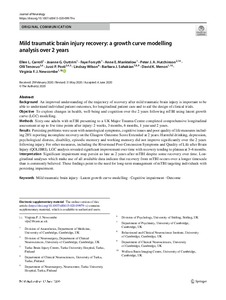Mild traumatic brain injury recovery: a growth curve modelling analysis over 2 years
Ellen L. Carroll; Joanne G. Outtrim; Faye Forsyth; Anne E. Manktelow; Peter J. A. Hutchinson; Olli Tenovuo; Jussi P. Posti; Lindsay Wilson; Barbara J. Sahakian; David K. Menon; Virginia F. J. Newcombe
Mild traumatic brain injury recovery: a growth curve modelling analysis over 2 years
Ellen L. Carroll
Joanne G. Outtrim
Faye Forsyth
Anne E. Manktelow
Peter J. A. Hutchinson
Olli Tenovuo
Jussi P. Posti
Lindsay Wilson
Barbara J. Sahakian
David K. Menon
Virginia F. J. Newcombe
SPRINGER HEIDELBERG
Julkaisun pysyvä osoite on:
https://urn.fi/URN:NBN:fi-fe2021042713797
https://urn.fi/URN:NBN:fi-fe2021042713797
Tiivistelmä
Background: An improved understanding of the trajectory of recovery after mild traumatic brain injury is important to be able to understand individual patient outcomes, for longitudinal patient care and to aid the design of clinical trials.
Objective: To explore changes in health, well-being and cognition over the 2 years following mTBI using latent growth curve (LGC) modelling. Methods Sixty-one adults with mTBI presenting to a UK Major Trauma Centre completed comprehensive longitudinal assessment at up to five time points after injury: 2 weeks, 3 months, 6 months, 1 year and 2 years.
Results: Persisting problems were seen with neurological symptoms, cognitive issues and poor quality of life measures including 28% reporting incomplete recovery on the Glasgow Outcome Score Extended at 2 years. Harmful drinking, depression, psychological distress, disability, episodic memory and working memory did not improve significantly over the 2 years following injury. For other measures, including the Rivermead Post-Concussion Symptoms and Quality of Life after Brain Injury (QOLIBRI), LGC analysis revealed significant improvement over time with recovery tending to plateau at 3-6 months. Interpretation Significant impairment may persist as late as 2 years after mTBI despite some recovery over time. Longitudinal analyses which make use of all available data indicate that recovery from mTBI occurs over a longer timescale than is commonly believed. These findings point to the need for long-term management of mTBI targeting individuals with persisting impairment.
Kokoelmat
- Rinnakkaistallenteet [27094]
